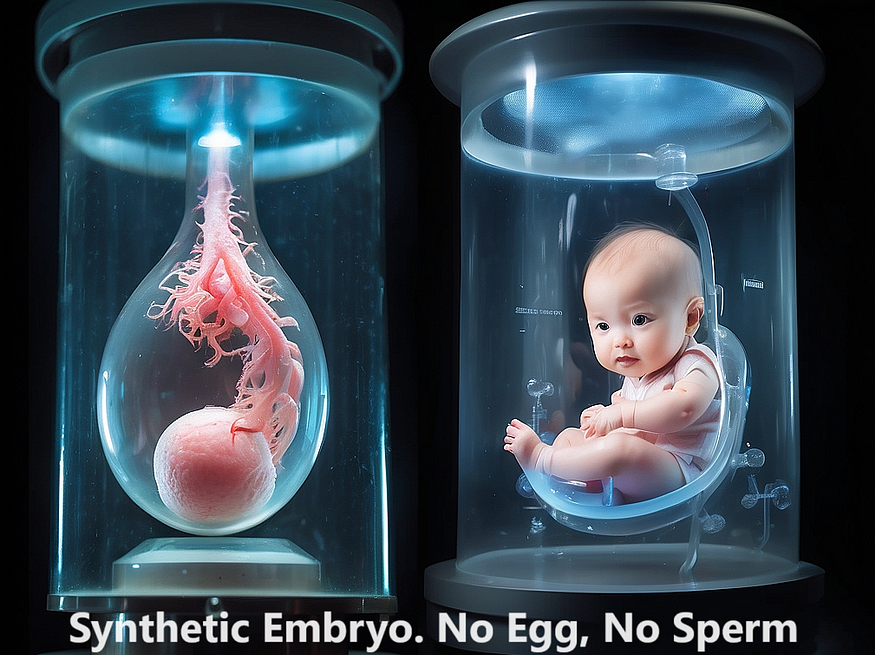Scientists playing God
Lab-Created Babies: a Potential Reality

In a major breakthrough, the University of Cambridge has successfully generated the first synthetic human embryos in a laboratory using stem cells. These synthetic embryos have been developed up to a stage equivalent to 14 days old, which is a critical time in the study of natural embryos. This achievement provides an opportunity to gain significant insights into early miscarriages and unravel the complexities of organ development. The scientific potential of this breakthrough is enormous, and the possibilities for further advancements are limitless.
Understanding Synthetic Embryos
The term “synthetic embryos” might be somewhat misleading. These structures are not entirely synthetic, nor are they exact replicas of natural embryos. They resemble early embryos, tiny clusters of cells originating from the fertilization of an egg by a sperm, but are constructed in a lab. from cultured stem cells. It is important to note that the stem cells used in this process are derived from embryos, which creates distinctions from naturally formed embryos. Some experts refer to these entities as stem-cell-based embryo models.
Unprecedented Advancements
Until recently, synthetic embryos had been successfully developed only in animals like mice and monkeys. However, Magdalena Żernicka-Goetz and her team at the University of Cambridge have pushed the boundaries by cultivating human versions to a stage equivalent to the implantation phase in natural embryos. This breakthrough allows scientists to explore the development of various tissues, including those that give rise to sperm and eggs.
Żernicka-Goetz presented her team’s work at the International Society for Stem Cell Research’s annual meeting in Boston, Massachusetts, highlighting the growth of synthetic embryos beyond what was previously achieved. However, the full details of the research are yet to be published in a peer-reviewed paper.
The Significance of Synthetic Embryos
The creation of synthetic embryos offers significant promise for multiple reasons. One major advantage is the ability to generate them in unlimited quantities, which helps address the shortage of spare in vitro fertilization (IVF) embryos typically used in early developmental research. Furthermore, embryos produced from the same batch of stem cells are genetically identical, making it easier to study their responses to diverse experimental situations. Additionally, it is quicker and more straightforward to genetically modify stem cells in a dish, which allows for a deeper understanding of the functions of different genes.
Ethical Considerations and Regulatory Framework
In many countries, including the UK and the US, natural embryos studied in a laboratory must be destroyed after 14 days to sidestep ethical concerns associated with potential fetal development. This time limit doesn’t apply to synthetic embryos, allowing researchers to study embryonic development for extended periods. In response to this evolving landscape, efforts are underway to formulate new regulations tailored explicitly to synthetic embryos.
In the UK, a working group comprising scientists, legal experts, patient representatives, and ethicists, including Magdalena Żernicka-Goetz, is actively discussing and recommending new rules. The UK’s Human Fertilisation and Embryology Authority is expected to be responsible for regulating research involving synthetic embryos. Proposed regulations may focus on the developmental stage of artificial embryos rather than a fixed time limit, potentially aligning with the formation of specific organ systems.
Potential Impact on Medicine
Scientists can gain a better understanding of early embryonic development through the creation of synthetic embryos. Currently, researchers are limited by the 14-day rule, which prevents them from studying human embryos beyond a certain stage. Synthetic embryos can help researchers study the critical period of early pregnancies and the causes of miscarriages. This can lead to breakthroughs in reproductive medicine. By studying embryonic organ formation and growth, researchers may also be able to grow organs in laboratories for transplantation, which could be a significant advancement in the field of regenerative medicine.
The legal and ethical dilemmas.
The quick advancements in synthetic embryo research have led to discussions about ethical and legal guidelines. Unlike traditional human embryos created through in vitro fertilization, stem cell-derived models of human embryos lack clear regulations. James Briscoe of the Francis Crick Institute stresses the need for guidelines to govern the development and use of these models.
The shortage of specific laws regarding synthetic embryos has raised important questions globally. The United States, along with other countries, lacks comprehensive regulations that address the creation and treatment of synthetic embryos. It is essential to establish a regulatory framework to keep up with scientific progress.
The Scientific Landscape: Challenges and Possibilities
Despite the monumental strides made in synthetic embryo research, numerous challenges remain. The viability of transferring synthetic embryos into a uterus, a prospect currently illegal and unexplored, raises intriguing questions. Animal research, particularly involving synthetic embryos in monkeys, has suggested that pregnancies initiated by such embryos may miscarry after a few days.
This outcome might be attributed to the differences between synthetic and natural embryos. Roger Sturmey from Hull York Medical School cautions against assuming that synthetic embryos entirely recapitulate human embryonic development. Uncertainties persist regarding their potential to develop beyond a few days, posing questions about whether the limitations are purely technical or rooted in fundamental biological factors.
The Road Ahead: Balancing Progress with Regulation
As synthetic embryo research evolves, striking a balance between scientific progress and ethical considerations remains paramount. The unprecedented ability to study embryonic development beyond the 14-day rule opens new avenues for understanding and addressing early pregnancy challenges. The collaborative efforts of scientists, legal experts, ethicists, and policymakers are instrumental in shaping the regulatory landscape, ensuring that the ethical dimensions of synthetic embryo research are appropriately addressed.
In conclusion, creating human synthetic embryos marks a pivotal moment in scientific exploration, offering unprecedented opportunities to unravel the mysteries of embryonic development. While ethical and regulatory challenges persist, the potential benefits of understanding and advancing reproductive medicine underscore the significance of ongoing research in this transformative field.
Comments
Post a Comment